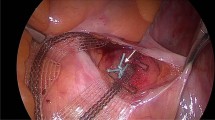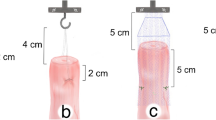Abstract
Background
The physical properties of three commercial 5-mm myoma-fixation devices available for clinical use (short-pitch corkscrew, long-pitch corkscrew, buttress-thread screw) and a standard wood screw were examined.
Methods
Fresh specimens of uterine leiomyoma masses were used to test the maximum traction force obtained from each device on 31 occasions. The myoma tissue at each traction site was evaluated histologically to determine its density. The maximal traction forces in each myoma density group were compared using a generalized estimating equations approach to linear regression based on repeated measures within each myoma. The bending strength also was determined for each device.
Results
A wide range of maximum traction forces with a mean of 130.8 ± 71.5 N (range, 21.6–341.6 N) over all devices and tissue densities was recorded. The mean maximum traction force provided by the short-pitch corkscrew (159.2 ± 12.2 N) was significantly higher (p < 0.01) than that of the other devices in medium-density myomas, and not significantly lower than that of other devices in low-density myomas. The mean maximum traction force provided by the buttress-thread screw was significantly lower than that of the short-pitch corkscrew only in medium density myomas, and did not differ significantly from that of the wood screw in any density group. The wood screw provided the highest bending strength (6.73 × 104 N/m) (whereas the short- and long-pitch corkscrew provided the lowest (9.70 × 102 N/m and 1.95 × 103 N/m, respectively) and the buttress-thread screw an intermediate (2.24 × 104 N/m) strength (p < 0.0005 for all comparisons except for the two corkscrews).
Conclusions
Screw-type myoma-fixation devices can provide comparable traction force with high bending strength. A long-pitch corkscrew should not be used for laparoscopic myomectomy because of its low traction force and bending strength. When a commercial screw is not available, a standard wood screw can be used with acceptable traction force and very high strength for bending.





Similar content being viewed by others
References
SE Asnis JJ Ernberg MPG Bostrom TM Wright RM Harrington A Tencer M Peterson (1996) ArticleTitleCancellous bone screw thread design and holding power J Orthop Trauma 10 462–469 Occurrence Handle1:STN:280:ByiD2cjit1E%3D Occurrence Handle8892145
JR Chapman RM Harrington KM Lee PA Anderson AF Tencer D Kowalski (1996) ArticleTitleFactors affecting the pullout strength of cancellous bone screws J Biomech Eng 118 391–398 Occurrence Handle1:STN:280:ByiD38ngvVc%3D Occurrence Handle8872262
D Cohen MT Mazur MA Jozefczyk SZA Badawy (1994) ArticleTitleHyalinization and cellular changes in uterine leiomyomata after gonadotropin releasing hormone agonist therapy J Reprod Med 39 377–380 Occurrence Handle1:STN:280:ByuA2czjsFA%3D Occurrence Handle7520497
L Deligdisch S Hirschmann A Altchek (1997) ArticleTitlePathologic changes in gonadotropin-releasing hormone agonist analogue treated uterine leiomyomata Fertil Steril 67 837–841 Occurrence Handle1:STN:280:ByiB2sjltVc%3D Occurrence Handle9130887
JB Dubuisson A Fauconnier K Babaki-Fard C Chapron (2000) ArticleTitleLaparoscopic myomectomy: a current view Hum Reprod Update 6 588–594 Occurrence Handle11129692
T Gausepohl R Möhring D Pennig J Koebke (2001) ArticleTitleFine thread versus coarse thread: a comparison of the maximum holding power Injury 32 IssueIDSuppl 4 SD1–7
C Koh G Janik (2003) ArticleTitleLaparoscopic myomectomy: the current status Curr Opin Obstet Gynecol 15 295–301 Occurrence Handle12858101
A Rossetti M Paccosi O Sizzi S Zulli S Mancuso A Lanzone (1999) ArticleTitleDilute ornitin vasopressin and a myoma drill for laparoscopic myomectomy J Am Assoc Gynecol Laparosc 6 189–193 Occurrence Handle1:STN:280:DyaK1M3ksVyjsg%3D%3D Occurrence Handle10226131
H Takeuchi R Kuwatsuru (2003) ArticleTitleThe indications, surgical techniques, and limitations of laparoscopic myomectomy JSLS 7 89–95 Occurrence Handle12856836
Author information
Authors and Affiliations
Corresponding author
Rights and permissions
About this article
Cite this article
Tintara, H., Aiyarak, P., Mitarnun, W. et al. Assessment of the physical properties of laparoscopic myoma-fixation devices. Surg Endosc 19, 240–244 (2005). https://doi.org/10.1007/s00464-004-9018-3
Received:
Accepted:
Published:
Issue Date:
DOI: https://doi.org/10.1007/s00464-004-9018-3




